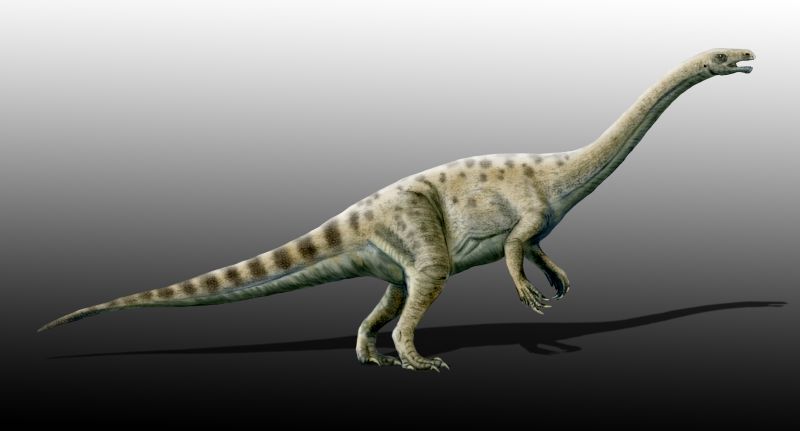Adeopapposaurus on:
[Wikipedia]
[Google]
[Amazon]
 ''Adeopapposaurus'' (meaning "far eating lizard", in reference to its long neck) is a
''Adeopapposaurus'' (meaning "far eating lizard", in reference to its long neck) is a
 The following cladogram shows the position of ''Adeopapposaurus'' within Massopoda, according to Oliver W. M. Rauhut and colleagues, 2020:
The following cladogram shows the position of ''Adeopapposaurus'' within Massopoda, according to Oliver W. M. Rauhut and colleagues, 2020:
 ''Adeopapposaurus'' (meaning "far eating lizard", in reference to its long neck) is a
''Adeopapposaurus'' (meaning "far eating lizard", in reference to its long neck) is a genus
Genus (; : genera ) is a taxonomic rank above species and below family (taxonomy), family as used in the biological classification of extant taxon, living and fossil organisms as well as Virus classification#ICTV classification, viruses. In bino ...
of plateosaurian dinosaur
Dinosaurs are a diverse group of reptiles of the clade Dinosauria. They first appeared during the Triassic Geological period, period, between 243 and 233.23 million years ago (mya), although the exact origin and timing of the #Evolutio ...
from the Early Jurassic
The Early Jurassic Epoch (geology), Epoch (in chronostratigraphy corresponding to the Lower Jurassic series (stratigraphy), Series) is the earliest of three epochs of the Jurassic Period. The Early Jurassic starts immediately after the TriassicÔ ...
Ca├▒├│n del Colorado Formation of San Juan San Juan, Spanish for Saint John (disambiguation), Saint John, most commonly refers to:
* San Juan, Puerto Rico
* San Juan, Argentina
* San Juan, Metro Manila, a highly urbanized city in the Philippines
San Juan may also refer to:
Places Arge ...
, Argentina
Argentina, officially the Argentine Republic, is a country in the southern half of South America. It covers an area of , making it the List of South American countries by area, second-largest country in South America after Brazil, the fourt ...
. It was similar to ''Massospondylus
''Massospondylus'' ( ) is a genus of sauropodomorph dinosaur from the Early Jurassic of southern Africa. It was described by Sir Richard Owen in 1854 from remains discovered in South Africa, and is thus one of the first dinosaurs to have been ...
''. Four partial skeletons with two partial skulls are known.
The type specimen
In biology, a type is a particular wikt:en:specimen, specimen (or in some cases a group of specimens) of an organism to which the scientific name of that organism is formally associated. In other words, a type is an example that serves to ancho ...
, PVSJ568, includes a skull and most of a skeleton
A skeleton is the structural frame that supports the body of most animals. There are several types of skeletons, including the exoskeleton, which is a rigid outer shell that holds up an organism's shape; the endoskeleton, a rigid internal fra ...
to just past the hips. The form of the bones at the tips of the upper and lower jaws suggests it had keratin
Keratin () is one of a family of structural fibrous proteins also known as ''scleroproteins''. It is the key structural material making up Scale (anatomy), scales, hair, Nail (anatomy), nails, feathers, horn (anatomy), horns, claws, Hoof, hoove ...
ous beaks. The fossils now named ''Adeopapposaurus'' were first thought to represent South American
South America is a continent entirely in the Western Hemisphere and mostly in the Southern Hemisphere, with a considerably smaller portion in the Northern Hemisphere. It can also be described as the southern Subregion#Americas, subregion o ...
examples of ''Massospondylus
''Massospondylus'' ( ) is a genus of sauropodomorph dinosaur from the Early Jurassic of southern Africa. It was described by Sir Richard Owen in 1854 from remains discovered in South Africa, and is thus one of the first dinosaurs to have been ...
''; while this is no longer the case, ''Adeopapposaurus'' is classified as a massospondylid
Massospondylidae is a family (biology), family of early massopod dinosaurs that existed in Asia, Africa, North America, South America and AntarcticaHellert, Spencer M. "A New Basal Sauropodomorph from The Early Jurassic Hanson Formation of Antarc ...
. ''Adeopapposaurus'' was described in 2009 by Ricardo N. Mart├şnez. The type species
In International_Code_of_Zoological_Nomenclature, zoological nomenclature, a type species (''species typica'') is the species name with which the name of a genus or subgenus is considered to be permanently taxonomically associated, i.e., the spe ...
is ''A. mognai'', referring to the Mogna locality where it was found. The found fossils of ''Adeopapposaurus'' have provided crucial information about the different types of sauropod dinosaurs that were located in South America.Apaldetti, Cecilia, et al. ÔÇťA new basal sauropodomorph (Dinosauria: Saurischia) from Quebrada del Barro Formation (Marayes-El Carrizal Basin), northwestern Argentina.ÔÇŁ PLoS ONE, vol. 6, no. 11, 2011, https://doi.org/10.1371/journal.pone.0026964. Mart├şnez, R. N. (2009). ''Adeopapposaurus mognai'', gen. et sp. nov. (Dinosauria: Sauropodomorpha), with comments on adaptations of basal Sauropodomorpha. Journal of Vertebrate Paleontology, 29(1), 142-164. 10.1671/039.029.0102
Phylogeny
See also
* 2009 in paleontologyReferences
Massospondylidae Dinosaur genera Early Jurassic dinosaurs Dinosaurs of Argentina Fossil taxa described in 2009 {{interwiki extra, qid=Q936945